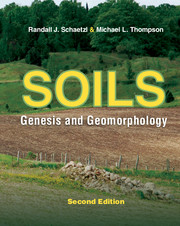11 - Pedoturbation
Published online by Cambridge University Press: 12 January 2024
Summary
Pedoturbation, a word popularized by Francis Hole (1961), is synonymous with soil mixing. The mechanisms and vectors by which physical mixing is accomplished are many, and they operate from microscopic scales at which crystals grow and deteriorate, to larger mixing processes associated with uprooted trees, to massive termite mounds and solifluction lobes. The importance of pedoturbation has traditionally been underemphasized by many soil and earth scientists. Nonetheless, it is ubiquitous, and its importance to soil and landscape genesis is becoming increasingly documented. Pedoturbation may promote horizonation and physical organization in a soil, but it can also be a regressive (mixing) process that promotes disorder. In short, although it is a form of mixing, pedoturbation is not, as we shall see, always synonymous with homogenization.
Pedoturbation affects soil genesis and its developmental pathways almost continually, but it often is little noticed. Knowledge of pedoturbation is vital for the study of preexisting stratification, such as in archaeology (Wood and Johnson 1978, Rolfsen 1980, Stein 1983, Bocek 1986, McBrearty 1990, Balek 2002) and sedimentology, as well as for those who study pedogenic layering, e.g., soil scientists or geomorphologists (Johnson et al. 1987). For example, geological lithologic discontinuities can be blurred or completely masked by pedoturbation processes. Alternatively, layering formed by pedoturbation processes can be mistakenly attributed to geological processes that operated prior to pedogenesis. Pedoturbation plays a critical role in maintaining macroporosity in most soils, which in turn aids in infiltration and retards runoff and erosion. Physical mixing of organic matter in surface litter layers into the underlying soil is largely accomplished via pedoturbation. In short, most pedogenic pathways are in some way affected by pedoturbation.
Many traditional soil genesis studies have focused on ascertaining how and why the soil profile (an ordered state) has developed. Comparatively few studies, however, have stressed or examined the converse – the formation of disorder (haploidization, simplification) from an otherwise pedologically ordered soil, i.e., one with horizons (see Chapter 12). Still fewer have examined the preservation of disorder by pedoturbation, or the formation of soil order by pedoturbation. This oversight is the impetus for this chapter.
Expressions of Pedoturbation
In its various forms (Table 11.1), pedoturbation is studied either by observing the process, such as ants moving soil particles (Pérez 1987b), or by examining and interpreting the end products of pedoturbation (Baxter and Hole 1967, Schaetzl 1986b, Cox et al. 1987a, Johnson 2002, Robertson and Johnson 2004).
- Type
- Chapter
- Information
- SoilsGenesis and Geomorphology, pp. 232 - 282Publisher: Cambridge University PressPrint publication year: 2015



